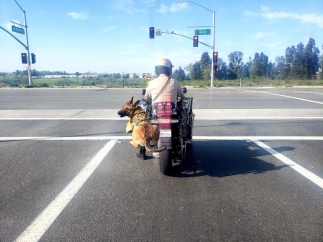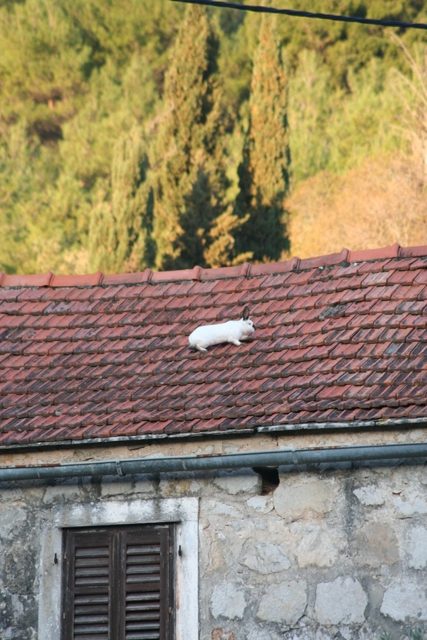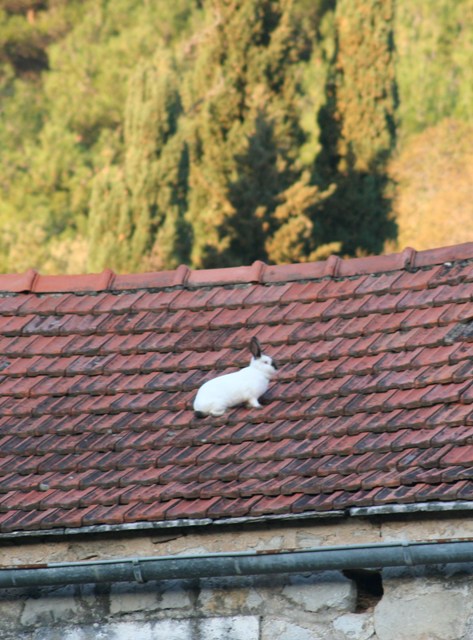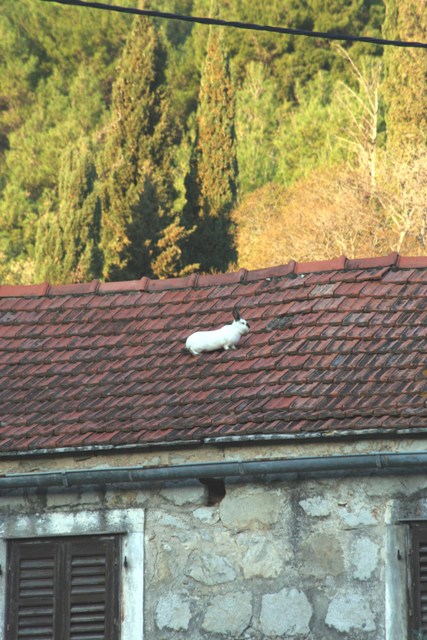Blood rain

This week: Blood rain; Cuttings; Killing weeds;
I’d just like to clear something up.
Yes, I have Adobe Photoshop. I also have the lesser known but equally powerful CORELDraw and CORELPaint, but I use the software tools to repair photographs rather than to make things appear in photographs which were not there!

https://247headline.com/temecula-police-department-begins-use-of-k9-motor-officers/
Last week I included the photo of the Easter Bunny skipping across a roof.

A friend thought that I had photoshopped – the term a recent addition to the OED – the photo.

No, really, I saw the furry mammal skipping across the roof of building close to home.

True, it’s not something you would expect to see. In fact it is more likely to be the result of imbibing something fairly strong, but in this case it is genuine.
The camera does lie. Cameras actually lie quite frequently, and occasionally I will take a photo that I know will cause some head scratching. Like this one of a new “Air Bubble” system to move helicopters around.

But in respect of the Easter Bunny, it is genuine, and it has also been witnessed by neighbours. I did find my chocolate eggs that he left too.
Blood rain
There has been strange Easter weather across most of Europe. The four countries which form the United Kingdom, England, Scotland, Wales and Northern Ireland, each saw the highest temperature ever recorded for Easter. Granted, this year Easter is almost as late as it is possible to be, but even so, temperatures above 25ºC in the UK, In April are not a normal occurrence.
While north of the Alps and Pyranees the temperatues have been high, to the south they are below the average for the time of year. I have recorded a drop of 3ºC over previous year’s average for this week in the year.
Then when we had rain on Monday and Tuesday nights, the quantity was much lower than expected, only around 1mm, but what we have had is huge amounts of sand from the Sahara Desert being blown up.

This is a photo on a sunny afternoon from my study. The island of Brač is almost invisible and when I went to the supermarket, the Dinaric Alps, normally a pristine horizon to the east, were completely invisible.

Atmospheric sand
The small amount of rain we did experience left a deposit of red sand on all the cars, in fact on everything, but most noticably on vehicles. This is coloquially called blood rain.
The European Centre for Severe Weather has an article describing the cause and also tracking the extent of the air pollution, which has reached as far as Scandinavia. It is just another weather anomaly which is difficult to explain away.
Cuttings
Sometimes the lack of variety of plants here makes me wonder why. This being the Mediterranean, we of course have Bougainvillea. That spiny, showy, leggy shrub which was discovered in a South American jungle by Philibert Commerçon, a botanist accompanying French Navy admiral Louis Antoine de Bougainville, after whom the genus was named and brought to Europe to the French Court
Now Bouganvillea is endemic across the region and indeed anywhere which has a Mediterranean climate. But when it comes to colours, you are restricted in what you can buy here. It is really only cerise, in shades of dark to light.

There is no white, no deep red, no chartreuse and none of one of my favourites, California Gold.

I had one of these in Abu Dhabi, but the temperature there was at the hot end of what climate it could withstand, so while it grew, it hardly thrived. It is a pale orange/yellow colour and completely distinctive. Although I tried at the big nursery in Split, they said they couldn’t get it.

I was sent a bundle of cuttings this week from a California Gold shrub. They arrived by post, well packed and ready for planting. But to be successful with some shrubs, and Bougainvillea is one, they need a fairly constant bottom heat of 25ºc to 30ºc.
I made my own heated propagator a couple of years ago, but only bought a thermostat to control the heating cable this spring. So with the arrival of the cuttings, I put them in water and finished off the propagator heating system.
It is on the shelf in the greenhouse, so gets sun from sunrise to sunset at this time of year. I needed to do a bit of drilling to get the sensor into the sand, and then tidy up the mains wiring.

The thermostat unit is made by Elixir and out of the box, it will accept any number of plugs. But the Schuko plugs used here are the type which have earth connectors on the side. I needed a plug which had an earth connector that would go into the thermostat. Having changed many UK Type G plugs to European Schuko, I got a Type G out of the box of spares I keep, and changed the cable plug back to a UK fitting.
I had a look before to make sure that the soil warming cable did indeed have an earth wire, which it did, then went ahead and made all the changes.
The sand which is used to enclose the warming cable is kept damp. Even incompetent electricians know that moisture and electricity do not mix, so if the cable manufacturer includes an earth wire, it is there for a purpose! Don’t ignore it!!
I’ve set the thermostat to 28ºC and it is gently ticking over. There is quite a good Wiki How-to article, if you are not familiar with rooting this kind of cutting.
Each of the hardood cuttings is dipped in hormone rooting powder before being planted in pots.

I used John Innis Potting Soil as the base in 9 cm pots. With 12 cuttings in my parcel, I am planting some singly in pots, and some two to a pot, to see what happens.

I use supermarket fruit & veg plastic bags – repurposed – to cover the pots and will now have to wait and see how many of the cuttings take. My propagation book says it can be 8 to 12 weeks before you see the signs that rooting has taken place, so it will be another “wait and see”.
Killing weeds
I have been dutifully irrigating the row of seeds I planted in the new bed in the top orchard some four weeks ago.

This week, there was an abundance of weeds and not a single Aubretia to be seen.

I’ve really lavished lots of TLC on these seeds, making sure they have been kept moist, so I have put a new lot of seeds in the propagator, but this time in plugs rather than direct sowing into the soil.

I really don’t know why some seeds fail. Clearly it’s not the soil, by the number of weedlings which have germinated. But while the weeds are small I have gone over the bed with a Dutch hoe to remove everything.
This soil is the riddled remains of the compost heap mixed with recovered top soil from the area around the stone steps. Riddling the soil to remove the small stones has really opened the soil weed seed bank. I suspect I will have to keep on top of these weeds for the rest of the year, as each generation of seeds germinate.
It’s a shame that you cannot get the same germination rate from flower seeds. But then if you could, we would probably call them weeds… NRC
4 Responses
Andy Obridge
Photo’s don’t lie Norman, they just illusinate!
My visibility has been well down, not seen your island for a few days. About the sand, now you know why my auto is sandglow yellow, it doesn’t show!
About the colours. I do have some really colourful weeds! Shame to strim them but all around the trees has to be done. Many use weed killer but not me. Truly organic, no chemicals on my olives at all.
The forecast rainfall hasn’t been as you say. I just have to watch my water meter does not go into orbit when I try to keep what little I plant green coloured!
Another fascinating read. Thanks.
Tony Griggs
Love the aerial photo of the port at Yr town Norman. Bet it gets overwhelmed in summer! Best you stay tucked away in Yr village in the hills! Finally rain here! Winter looks to be coming early!
Marcy
Love your detail and photos especially the flowers and potting info. Thank you.
Marcy
Love your detail and photos especially the flowers and potting info. Thank you. Btw today it’s snowing in Colorado. Lol